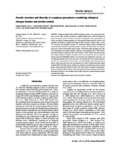Please use this identifier to cite or link to this item:
http://www.alice.cnptia.embrapa.br/alice/handle/doc/1011684| Title: | Genetic structure and diversity of a soybean germplasm considering biological nitrogen fixation and protein content. |
| Authors: | TORRES, A. R.  GRUNVALD, A. K.   MARTINS, T. B.   SANTOS, M. A. dos   LEMOS, N. G.   SILVA, L. A. S.   HUNGRIA, M.   |
| Affiliation: | ADALGISA RIBEIRO TORRES; ANNA KAROLINA GRUNVALD; TALITA BUSULINI MARTINS; MARIA APARECIDA DOS SANTOS, PIONEER; NOÉLLE GIACOMINI LEMOS, MONSATO; LUIS ANTONIO STABILE SILVA, PIONEER; MARIANGELA HUNGRIA DA CUNHA, CNPSO. |
| Date Issued: | 2015 |
| Citation: | Scientia Agricola, Piracicaba, v. 72, n. 1, p. 47-52, Jan./Feb. 2015. |
| Description: | Biological nitrogen fixation (BNF) has global economic and environmental importance, but has often not been considered in soybean [Glycine max (L.) Merrill] breeding programs. Knowing the genetic diversity and structure of a population within a germoplasm represent a key step for breeding programs. This study aimed at determining the structure of the population and diversity of soybean with regard to BNF and protein content in grain. In total, 191 accessions were evaluated, including 171 commercial soybean cultivars, developed and released by public institutions and private companies in Brazil, and 20 ancestral lines. The genotypes were chosen to represent four genetic groups: 128 Brazilian public genotypes, 20 exotic, and 43 genotypes from private companies. Soybeans were genotyped with 22 SSR markers, previously described as associated with BNF and protein content. Genetic diversity was evaluated using the DARwin 5.0 software. Population structure was inferred by principal component analysis and by the STRUCTURE software. The accessions were distributed in two groups: one clustering approximately 50 % of the accessions, from Brazilian public and private companies; the other one clustering 45 % of the accessions, including Brazilian, exotic and private germoplasms. Some accessions (5 %) were not grouped in any cluster. Principal component analysis explained 29 % of the total variance and there was a tendency to cluster the accessions into two groups. Similar results were obtained with the STRUCTURE, clearly showing two subpopulations. There is variability for BNF and protein content amongst both modern germoplasms cultivated in Brazil and ancestral lines. This variability could be better explored in soybean breeding programs to improve these traits. |
| Thesagro: | Soja Fixação de nitrogênio |
| NAL Thesaurus: | Soybeans Nitrogen fixation |
| ISSN: | 0103-9016 |
| Type of Material: | Artigo de periódico |
| Access: | openAccess |
| Appears in Collections: | Artigo em periódico indexado (CNPSO)  |
Files in This Item:
| File | Description | Size | Format | |
|---|---|---|---|---|
| neticstructureanddiversityofasoybeangermplasmconsideringbiological.pdf | 382.59 kB | Adobe PDF |  View/Open |









